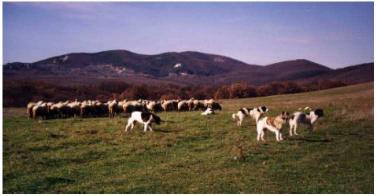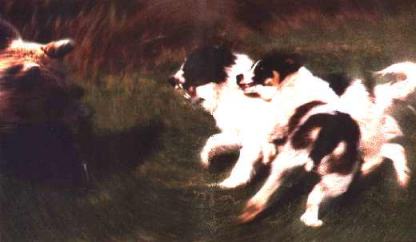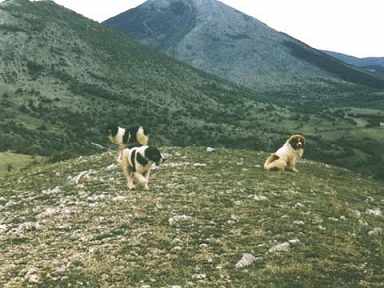|
Karakachan
Karakachansko Kuche, Karakachan Dog, Karakachan Hund |
|
||
|
|
|||
|
PRAKTICE
|
|
||
|
The Modern Karakachan Dog At Work As in prior historical times, the primary function of this livestock guardian breed remains the same: to protect its flock against the threat of predators. While
many predators have been placed on the endangered species list,
some populations have shown signs of recovery. Evidence is particularly
strong in Eastern Europe where large predators are returning to
areas where they had almost vanished. Modern farmers are now faced
with an age-old problem of protecting their livestock from attacking
wolves, bears, lynx, and others. Once again, farmers must return
to the traditions of their ancestors, redeveloping the standards
and practices of responsible livestock guarding through the use
of domesticated dogs. At the same time, modern legislation often
calls for environmental conservation, including the reestablishment
of wild carnivore populations, which is often at odds with the goals
and purpose of modern agriculture. Finding the balance between the
predator and the livestock prey has always been and continues to
be a delicate and challenging issue. Taking a cue from nature itself,
much can be learned from the herding traditions of regions where
large predators and large populations of livestock have managed
to coexist. Examples are readily found in the use of livestock guardian
dogs in the Italian highlands and the sheep herding techniques of
Eastern Europe. |
|||
|
|
|||
|
What is a livestock guardian dog (LGD)? Dogs have been used by people in Europe and Asia for millennia to guard domesticated animals against wild predators, stray or feral dogs and human thieves. Over the centuries, a distinct functional type of dog, known as livestock guardian or flock guard dog, was developed throughout Eurasia from Portugal to Tibet. LGDs protect the animals in their flock from external threats rather than help shepherds move their stock. Often consistent with the size of the livestock they guard, LGDs are usually large (often 70 to 75 cm at the withers and weighing about 50 kg). Most LGD breeds have a Mastiff-like large head with hanging rather than pricked ears. The LGD personality can be described as independent, intelligent and stubborn (in the sense that they are capable of making their own decisions). These dogs are devoted to family or flock members and wary of strangers. They may be less energetic than herding dogs but share calm dispositions, working steadily and fearlessly. They react quickly to perceived threats. Like
other dogs, LGDs are social animals: they have a great need to be
a member of a pack, |
|||
|
|
|||
|
LGDs are arguably an optimal and cost-effective method of predator control because they reduce the need for other forms of labour. They also lessen the need for night corralling. In addition, they make more efficient use of pasture land and their flock's potential expansion. They capably alert shepherds and farmers to any disturbances in the flock. They expertly protect their owner's family and property. Several US-based studies have noted that LGDs greatly reduce livestock depredation by predators (see USA LGD evaluation). In particular, Green (1984) reported that reducing predation was the greatest benefit of LGDs; at the same time, 87 percent of LGD users also felt greater peace of mind with their dogs present while 53 percent admitted to reducing reliance on other forms of predator control and 47 percent had eliminated night confinement of their livestock. Green concluded that a good LSD yielded few limitations and maximum benefit. The use of LGDs has also played a historical role in animal conservation in Europe. For example, Italian shepherds traditionally used LGDs as their pivotal control in balancing the coexistence of both sheep and wolves. Today, several similar conservation projects make use of LGDs, as is the case of the Karakachan in Bulgaria. LGD behaviour can be separated into three basic components: trustworthiness, attentiveness and protectiveness. The development of these qualities is considered critical for competency as a livestock guardian dog. · Trustworthiness. Absence of predatory behaviour is the basis of trustworthiness. Livestock-guardian dogs are selected who display investigative and submissive behaviours that do not threaten sheep or other livestock. An example of investigative behaviour involves sniffing around the head or anal areas. Submissive behaviours include approaching sheep with ears back and squinted eyes, avoiding direct eye contact, and lying on one's back. These desirable behaviours signify that a LGD has the right instincts and will working appropriately. · Attentiveness. The attraction of a guardian dog to a home site and to act as a surrogate littermate are the bases of attentiveness. Flock guardians are selected for their ability to follow other animals. While uninformed people might not understand, a livestock guardian dog that follows a moving flock and sleeps and loafs among the sheep are signs of attentiveness to sheep. A dog that retreats to its flock when a stranger approaches displays another positive sign of a sheep-attentive dog. Researchers have shown a direct correlation between attentiveness to livestock and a reduction in predation. Success depends on training LGD pups to follow sheep. · Protectiveness. The basis of protectiveness is a dog's ability to react to deviations from the normal routine. Flock guardians are thus selected for their ability to bark at new or strange activities. Typically, a young pup will respond to a new or strange situation by rushing out and barking with its tail raised over its back. If challenged, the pup may retreat to the flock or home site with its tail between its legs. This behaviour is known as approach-withdrawal. A predator, such as a coyote, usually avoids a guardian dog presenting approach-withdrawal behaviour, understanding it to be a warning. The dog rarely has to attack a predator that has learned to interpret the dog's behaviour correctly. Interactions with potential predators often involve complex behaviours that are more difficult to interpret. Approach-withdrawal behaviour may quickly shift into an aggressive display of dominance or a hasty retreat to the sheep, also depending on the behaviour displayed by the predator. The dog's behaviour might be magnified if defending food or exhibiting maternal-like defence of a young lamb. The distance of the approach toward strange activity increases as the dog matures. The distance a dog travels varies with individuals but rarely extends beyond the boundaries of the herd. |
|||
|
|
|
©
2005 Semperviva
|


